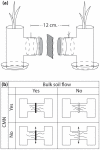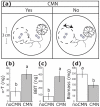The fungal fast lane: common mycorrhizal networks extend bioactive zones of allelochemicals in soils
- PMID: 22110615
- PMCID: PMC3215695
- DOI: 10.1371/journal.pone.0027195
The fungal fast lane: common mycorrhizal networks extend bioactive zones of allelochemicals in soils
Abstract
Allelopathy, a phenomenon where compounds produced by one plant limit the growth of surrounding plants, is a controversially discussed factor in plant-plant interactions with great significance for plant community structure. Common mycorrhizal networks (CMNs) form belowground networks that interconnect multiple plant species; yet these networks are typically ignored in studies of allelopathy. We tested the hypothesis that CMNs facilitate transport of allelochemicals from supplier to target plants, thereby affecting allelopathic interactions. We analyzed accumulation of a model allelopathic substance, the herbicide imazamox, and two allelopathic thiophenes released from Tagetes tenuifolia roots, by diffusion through soil and CMNs. We also conducted bioassays to determine how the accumulated substances affected plant growth. All compounds accumulated to greater levels in target soils with CMNs as opposed to soils without CMNs. This increased accumulation was associated with reduced growth of target plants in soils with CMNs. Our results show that CMNs support transfer of allelochemicals from supplier to target plants and thus lead to allelochemical accumulation at levels that could not be reached by diffusion through soil alone. We conclude that CMNs expand the bioactive zones of allelochemicals in natural environments, with significant implications for interspecies chemical interactions in plant communities.
Conflict of interest statement
Figures



References
-
- Callaway RM, Cipollini D, Barto K, Thelen GC, Hallett SG, et al. Novel weapons: Invasive plant suppresses fungal mutualists in America but not in its native Europe. Ecology. 2008;89:1043–1055. - PubMed
-
- Inderjit, Weston LA, Duke SO. Challenges, achievements and opportunities in allelopathy research. Journal of Plant Interactions. 2005;1:69–81.
-
- Bais HP, Vepachedu R, Gilroy S, Callaway RM, Vivanco JM. Allelopathy and exotic plant invasion: from molecules and genes to species interactions. Science. 2003;301:1377–1380. - PubMed
-
- Blair AC, Hanson BD, Brunk GR, Marrs RA, Westra P, et al. New tehniques and findings in the study of a candidate allelochemical implicated in invasion success. Ecology Letters. 2005;8:1039–1047.
-
- Macías FA, Galindo JLG, Galindo JCG. Evolution and current status of ecological phytochemistry. Phytochemistry. 2007;68:2917–2936. - PubMed
MeSH terms
Substances
LinkOut - more resources
Full Text Sources

